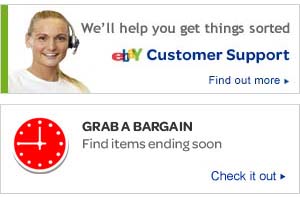We mentioned writing a call to action in our How to Write Effective Website Content earlier this month and now we’re going to look at how to write effective call to actions.
For those who don’t know, call to actions are used on websites to guide users through pages and content. Ultimately, users will end up at the point where they purchase an item, make an enquiry or whatever the end goal of the website is.
Take for example the below examples from eBay:
These call to actions are designed for those who wish to get assistance or purchase an item. Each one of these call to actions addresses a goal for eBay: whether it is the creation of a new user profile (which will have a monetary result for eBay at some point), assist a customer with an issue (increase brand retention and again, ultimately, this has an monetary value) or purchase an item (direct monetary value for eBay).
The end goal for eBay is to increase the amount of money spent through the site and so it assists its users in anyway it can, creating call to actions which address common needs for users.
Navigating your Website with Call to Actions
Before writing your call to actions think about which pages they are going to go on. Ideally each page will have a call to action on it, leading the user to a different part of the site which flows logically.
Take the following examples:
Home – Portfolio – Contact = enquiry
Home – Contact = enquiry
Also, it is important to remember that users may not necessarily land on the home page and so each page’s call to action should still be logical even if the user comes onto the site via a different landing page. For example:
Blog Post – Additional Blog Posts – About Us – Portfolio – Contact = enquiry
Blog Post – Portfolio = enquiry
Blog Post – Additional Blog Post – following on Social Media accounts
A handy way of working out what call to actions you need to write is to make a table of your site map (every page on your website), assign each page a number and then work out which page a user would be most likely to visit. You can then work out which page number links to which other page:
- Home
- About Us
- Portfolio
- Contact Us
1. Home — “Want to learn more about the work we do? Check out our portfolio…” — 3. Portfolio
2. About Us — “Contact us today if you wish to learn more about us…” — 4. Contact Us
You will find that some call to actions can be re-used for multiple pages such as on blog posts which tend to be linked to either additional blog posts or portfolio pages.
How to Write Effective Call to Actions
Once you have worked out which pages should link up, you can start drafting your call to actions. Call to actions can be altered over time to better fit your audience or to keep the site looking fresh. Furthermore, if you have a special offer / promotion on then use a call to action to increase the amount of hits to the page detailing it.
When writing your call to actions, think about the language and tone you wish to use; mirror the tone of the site. Your call to actions can be formal, informal, jokey or straight to the point.
For example:
- “Check out our portfolio to see our great work…”
- “Take a look at our portfolio to see our current clients…”
- “Fancy being part of our team? Take a peek at our current vacancies…”
If you wish you can include your products / services in your call to actions:
- “We love designing! Our passion is reflected in our work, check it out…”
- “Do you have a question about our teeth whitening services? Please contact us today to find out more…”
- “We’re situated in the heart of Bristol; pop in for a coffee…”
5 Tips for Writing Effective Call to Actions
Keep these top tips close to hand…
- Work out the user journey and how they are likely to navigate around your site
- Identify a problem the user may have and present a product that solves that problem
- Include user benefits if you are asking for additional user information i.e if a user signs up for a newsletter then reward them with a free service
- Focus on your call to actions – do not overload the user with actions everywhere
- Use active (and sometimes urgent) language eg. ‘Call now!’ or ‘This offer ends at midnight, act now!’





